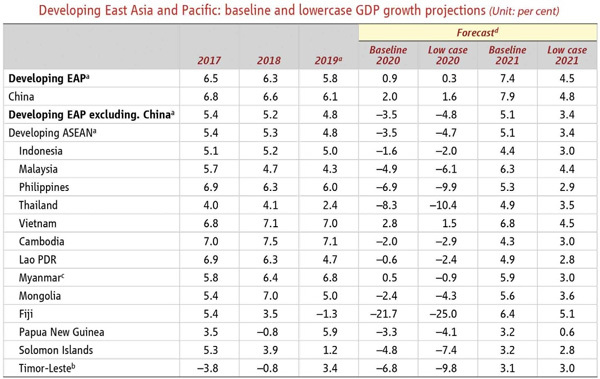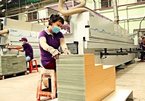 |
| Source: World Bank staff estimates. Note: a. Estimate, b. Nonoil GDP. c. Myanmar growth rates refer to the pre- and post-pandemic period for fiscal year from October to September, d. Baseline refers to a scenario of severe growth slowdown followed by a strong recovery. Lower case refers to a scenario of a deeper contraction followed by a sluggish recovery. Weighted averages are calculated for developing EAP. |
Carolyn Turk officially assumed the position of World Bank country director for Vietnam in July, at a time when the whole country had been struggling to fight the pandemic which is still causing serious problems worldwide.
“It is my great personal excitement to come back to Vietnam, where I lived and worked in various development agencies, including the World Bank for 15 years between 1993 and 2008,” Turk said.
According to her assessment, the world has to face what could be considered the biggest shock since World War 2. “For this reason, I’d like first to congratulate the government on the remarkable achievement in containing the COVID-19 pandemic. While other countries are now struggling, Vietnam has been able to contain the pandemic with only a limited number of deaths and infections,” Turk said. “The government’s exceptional management of the health crisis has been well recognised internationally and was again effective in containing the second wave in the central city of Danang in recent weeks. Vietnam’s economy is showing its strong resilience, with growth gradually recovering over the past months.”
Gradual recovery
The economy was reported last week by the General Statistics Office (GSO) to have bounced back strongly, at 2.62 per cent on-year in the third quarter of 2020, far higher than the 0.39 per cent rise in the second quarter, but remaining the lowest third-quarter growth level in the 2011-2020 period.
“COVID-19 has been well controlled, enabling the economy to gradually resume its operation in a new normalcy. Thus the third-quarter GDP grew flourishingly as compared to that in the second quarter,” outlined a GSO report on Vietnam’s nine-month economic situation.
Accordingly, in the third quarter, the agro-forestry-fishery sector increased 2.93 per cent on-year, while the industrial and construction sector rose 2.95 per cent on-year, and the service sector climbed 2.75 per cent on-year.
Notably, the quarter witnessed a total workforce of 48.5 million people, up 1.8 million people as compared to the second quarter.
In the first nine months of this year, the economy grew 2.12 per cent, also the lowest nine-month growth rate in the 2011-2020 period.
“However, in the current context of COVID-19 still badly affecting all activities in the economy, this rate is quite good as compared to many countries in the region and the wider world,” said GSO’s general director Nguyen Thi Huong. “This also demonstrates the sound direction in economic recovery and fighting the pandemic of the whole political system, the government, the prime minister, and all efforts of the public and the business community in implementing the government’s prime dual target of pandemic combating and socioeconomic development.”
In the first nine months, while the agro-forestry-fishery sector ascended 1.84 per cent on-year – creating 13.62 per cent of economic growth, the industrial and construction sector and the service sector expanded 3.08 and 1.37 per cent on-year, respectively, generating 58.35 and 28.03 per cent of economic growth, respectively.
Andrew Jeffries, country director for Vietnam of the Asian Development Bank (ADB), stated that he felt impressed at the resilience of the domestic economy. Prior to his undertaking his new position in Vietnam over a month ago, he often came to the country as a senior expert.
“Vietnam has been among few nations successfully controlling the pandemic,” Jeffries said.
The ADB forecasted that Vietnam’s economy is expected to grow 1.8 per cent in 2020 and then bounce back to 6.3 per cent in 2021.
“Lower domestic consumption and weak global demand caused by the pandemic have hurt Vietnam’s economy more than expected. But economic growth will be resilient in 2020, in large part due to the government’s success in controlling the spread of COVID-19,” said Jeffries. “Economic growth will be supported by the country’s macroeconomic stability, increased public spending, and ongoing reforms to improve the business environment.”
Vietnam’s economic outlook over the medium and long term remains positive. The country’s participation in a large number of bilateral and multilateral trade agreements will help Vietnam’s economic rebound. The nation will also likely benefit from the current shifting of supply chains to low-cost countries, the ADB stated.
Meanwhile, the World Bank last week released its October 2020 economic update for East Asia and Pacific titled “From Containment to Recovery”, stating, “Vietnam was able to control the pandemic at relatively low human and economic costs. Despite its high exposure to trade and deep engagement in global value chains, it is already beginning to see an economic revival.”
The World Bank’s fresh forecast showed that Vietnam will see the highest growth this year in the region (see box).
More than a week ago, US-based S&P Global Ratings, one of the three largest rating firms in the world, also released its fresh projection for Vietnam. Specifically, Vietnam is the second-best performer in terms of economic recovery in the Asia-Pacific region. The nation’s GDP will pick up by 1.9 per cent this year, and a further 11.2 per cent next year.
Rising confidence
It has been three months since 32-year-old Nguyen Van Hinh has resumed his normal work at Japanese-invested Mitto Denko Tape Co., Ltd. at Hanoi’s Thang Long Industrial Park. The business produced assorted tapes and protective films, which are locally consumed and exported to Japan, the US, and Europe. The firm had to halt part of its facilities due to COVID-19 during March and mid-June, affecting hundreds of workers like Hinh.
“From last month, the firm has resumed its all operations which are running at full speed, meaning our monthly salary of VND10 million ($435) has been ensured,” Hinh said. “Products have also continued to be exported overseas.”
His wife, Nguyen Thi Van, has also resumed her work at Japanese-invested FCC Vietnam Co., Ltd. also located at the industrial park. FCC makes automotive and motorcycles’ clutches, and other spare parts of the automotive and motorcycle industry to supply for Honda, Suzuki, and Yamaha, and also be exported to the US as well. FCC Vietnam resumed production in May, allowing more than 200 workers to come back to their work after nearly two months of layoff.
According to the Ministry of Planning and Investment’s Department of Industrial Economy, local production is beginning to climb after a few months of social distancing making a dent in almost all enterprises.
“Since May, a number of industrial sectors have seen an on-year significant rise, such as pharmaceuticals, electronics items, computers, and optical devices, paper products, and chemicals,” said a report from the department.
Results from a GSO survey on manufacturing and processing firms in the third quarter of 2020, announced last week, showed that 32.2 per cent of respondents said their performance in the third quarter is better than in the second quarter.
Some 45.6 per cent of respondents are expecting better performance in the fourth quarter against the third quarter. Foreign-invested enterprises are the most optimistic, with 82.8 per cent of respondents said they will perform better in the fourth quarter than in the third quarter. The respective rates of state-owned and local private enterprises are 81.7 and 80.2 per cent.
Regarding production tendency, 46 per cent of surveyed enterprises are expecting their production will be bigger in the fourth quarter, against the previous one. In terms of order, 43.2 per cent said their orders in the fourth quarter will be bigger than in the third quarter.
Also according to the GSO, in the first nine months of the year, the entire economy saw 99,000 businesses newly established with total registered capital of about VND1.43 quadrillion ($62.17 billion), down 3.2 per cent on-year in the number of enterprises, but up 10.7 per cent on-year in capital.
The average registered capital hit VND14.4 billion ($626,000), up 14.4 per cent on-year. If the VND2.17 quadrillion ($94.34 billion) in expanded capital from 29,500 operational businesses is included, total newly-registered and expanded capital into the nine-month economy is VND3.6 quadrillion ($156.62 billion), up 19.2 per cent on-year.
Furthermore, in the first nine months, 34,600 businesses resumed operations, up 25.5 per cent on-year, raising the total number of firms newly-established and resuming operations to about 133,600 up 2.9 per cent on-year. VIR
Khoi Nguyen

Vietnam may see negative GDP growth rate this year
Economists have predicted that Vietnam’s GDP may be negative this year as the possibility of a second outbreak exists.

VRDF highlights advantages of value chain development
Amid the heavy impact the pandemic has had so far on Vietnam’s economy, possible solutions to overcome the crisis and come out even stronger have been under discussion at this year’s Vietnam Reform and Development Forum.